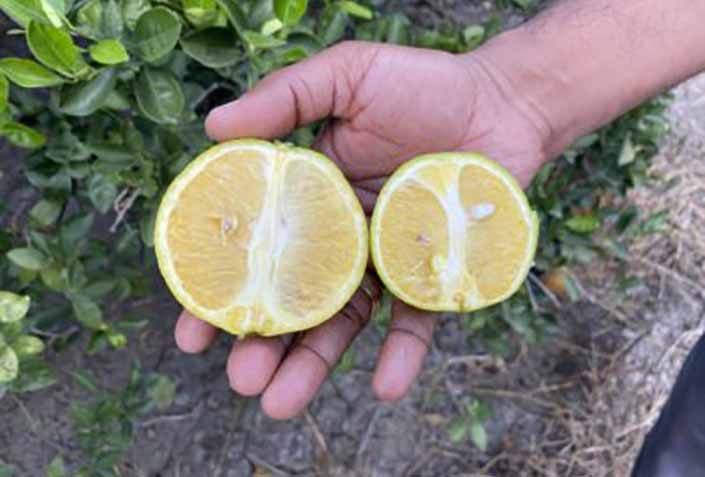‘Hairy roots’: Method creates supply of ‘unculturable’ pathogens for labs

Texas A&M AgriLife researchers have made a discovery that will help combat fastidious pathogens, which cost U.S. agriculture alone billions of dollars annually.
For the past few years, Kranthi Mandadi, a Texas A&M AgriLife Research scientist and associate professor in Texas A&M’s Department of Plant Pathology and Microbiology, along with his colleagues, has been working on developing new biological technologies to fight fastidious or “unculturable” pathogens. Mandadi and members of his team are based at the Texas A&M AgriLife Research and Extension Center in Weslaco.
The results of their work, “Plant hairy roots enable high throughput identification of new antimicrobials against Candidatus Liberibacter spp.,” were recently published in Nature Communications.
Fastidious plant pathogens infect citrus, tomatoes, potatoes, grapes, peppers and other crops grown throughout Texas. Often transmitted by insect vectors, these disease agents cause billions of dollars of damage each year. The U.S. citrus industry alone would save $3 billion per year through control of just one of these diseases — citrus greening. Additionally, the fastidious pathogen that causes Pierce’s Disease in grapes is the No.1 threat to the $1 billion wine industry in Texas.
“Currently, invasive fastidious pathogens are causing several major outbreaks in row crops, specialty crops and citrus, with immense costs to Texas and the U.S.,” said Juan Landivar, director of the AgriLife center at Weslaco, which has been involved in efforts to combat fastidious plant pathogens for many years.
Landivar said an expanded effort against fastidious plant diseases would protect the health of crops, environments, economies and people across the country.
Some plant pathogens can be grown as pure cultures in the laboratory in the presence of artificial nutrient solutions. Being able to culture disease agents in the lab facilitates their study by providing researchers with a reliable supply of experimental material. However, an estimated 99 percent of bacteria in the world are fastidious, or unable to grow outside their native environment.
“The greatest obstacle to understanding and controlling fastidious pathogens was the inability to cultivate them in a laboratory setting and to screen for lots of potential therapies,” said Leland “Sandy” Pierson, professor and head of Texas A&M’s Department of Plant Pathology and Microbiology. “But Dr. Mandadi and his team have developed a breakthrough method as an alternative means to propagate fastidious bacteria. These bacteria are believed to be responsible for Huanglongbing, also known as citrus greening disease, and other insect-vectored diseases such as potato zebra chip and tomato vein greening disease.”
The breakthrough came in the form of the “hairy root” system. This technology utilizes the pathogen-infected host tissues to produce so-called hairy roots that can serve as biological vessels for the propagation of these pathogens in the laboratory.
“Classical microbiological techniques developed early in the 19th century cultured animal and mammalian viruses in host cells, tissues and embryonated eggs,” Mandadi said. “In a similar manner, we hypothesized that plant hairy roots could be suitable for propagating fastidious pathogens. And indeed, hairy roots supported the accumulation and growth of fastidious plant bacteria.”
Microbial hairy roots appear similar to normal root tissues that develop from the plant and mimic a bacterium’s natural environment, he said. This allows the growth of the fastidious pathogens in controlled laboratory conditions.
While microbial hairy root cultures are not traditional “pure” test tube cultures, they allow on-demand access to the fastidious bacterium in the laboratory. This enables the expedited screening of diverse antimicrobials like chemical inhibitors, immune modulators as well as gene/CRISPR-based therapies.
Other advantages are that hairy root cultures are easy to produce in the laboratory and can be maintained for several months to a year in laboratory growth chambers. Depending on the pathogen and the efficacy of screening, it is also at least four times faster than conventional screening methods, according to Sonia Irigoyen and Manikandan Ramasamy, both AgriLife Research scientists and co-authors of the study.
In addition, the hairy root bioassays are scalable, so they can be used to pre-screen from a few to several hundred potential therapies simultaneously in a high-throughput manner. The microbial hairy root system can also be used to obtain mechanistic insights into antimicrobial function.
“Use of this technique has already led to the discovery of six new antimicrobial peptides with proven efficacy in plant materials,” Mandadi said. “These antimicrobials, either singly or in combination, could be used as near- and long-term therapies to control citrus greening, potato zebra chip and tomato vein greening diseases.”
More from the College of Agriculture & Life Sciences and Texas A&M AgriLife

